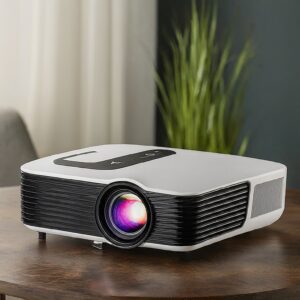Got a Chromebook and a projector? Let’s get them talking. You’ve got two main ways to do this: cables or going wireless. Knowing your options helps you pick the best way to show off your screen.

Cable Connection Options
Plugging in a cable is usually the easiest way to get your Chromebook and projector on the same page. Here’s a quick rundown of the popular types:
| Connection Type | What It Does |
|---|---|
| HDMI | Most common, gives you great audio and video. |
| DisplayPort | Good for high-res displays, also supports audio. |
| DVI | Mostly for video, found in older projectors. |
| USB-C | Newer Chromebooks might need adapters for HDMI or DisplayPort. |
To use HDMI, just plug one end into your Chromebook and the other into the projector. Don’t forget to select the HDMI input on the projector to see your Chromebook’s screen. If you’re using USB-C, make sure your cable can handle display output. Need more help? Check out this guide on mirroring your Chromebook to a projector.
Wireless Connection Methods
Ditch the cables! Wireless connections are super handy, especially in classrooms or meeting rooms. You can go wireless with a projector that has Wi-Fi or use a streaming device like Chromecast, Apple TV, or Roku.
To go wireless, make sure your projector is hooked up to Wi-Fi. Open Chrome on your Chromebook, hit the “Cast” option, and pick your projector from the list. If you’re using a projector like XGIMI, it might already have wireless features built-in, so no extra gadgets needed.
Pick the right method, and you’ll have your Chromebook’s screen up on the projector in no time, whether it’s for a presentation, movie night, or a classroom lesson.
How to Connect Your Chromebook to a Projector with HDMI
- Grab Your Gear: Make sure you’ve got an HDMI cable handy.
- Plug It In:
- Stick one end of the HDMI cable into your Chromebook.
- Plug the other end into your projector.
- Pick the Right Input:
- Fire up your projector.
- Use the remote or buttons on the projector to select the HDMI input. This should make your Chromebook’s screen show up on the projector.
- Tweak Display Settings (if needed):
- Click on the time in the bottom right corner of your Chromebook.
- Go to “Settings,” then “Device,” and hit “Displays.”
- Adjust the resolution or choose to mirror your screen.
Need a visual guide? Check out XGIMI’s tutorial.
Troubleshooting HDMI Issues
Running into problems? Here are some quick fixes:
| Problem | Fix |
|---|---|
| No Display on Projector | Make sure the HDMI cable is snugly connected to both devices. Double-check that the projector is set to the right HDMI input. |
| Crummy Image Quality | Adjust the resolution settings on your Chromebook to match the projector’s native resolution. You can do this in the display settings. |
| Projector Not Seeing Chromebook | Try a different HDMI cable or port. Restart both your Chromebook and the projector. |
| Screen Flickering | Inspect the HDMI cable for damage or loose connections. Test with another device to see if the projector is the issue. |
Still stuck? You might find our articles on projector overheating or replacing a projector lamp helpful.
Hooking Up Your Chromebook to a Projector with DisplayPort
Got a Chromebook and a projector but no HDMI? No worries! Using DisplayPort is a solid alternative. Here’s how to get everything connected and troubleshoot any hiccups along the way.
How to Connect via DisplayPort
- Check Your Gear: Make sure your Chromebook has a DisplayPort or you have an adapter that works.
- Plug It In: Connect one end of the DisplayPort cable to your Chromebook and the other to the projector.
- Pick the Right Input: Turn on the projector and use its remote or menu to select the DisplayPort input.
- Tweak Display Settings: On your Chromebook, click the time at the bottom-right, then the settings gear. Under “Device,” go to “Displays” to adjust resolution and orientation if needed.
Need more details? Check out our guide on mirroring a Chromebook to a projector.
Troubleshooting DisplayPort Issues
Running into problems? Here’s how to fix common issues:
| Problem | Fix |
|---|---|
| No signal on the projector | Ensure the DisplayPort cable is snugly connected to both devices. Confirm the projector is set to the correct input. |
| Projector not recognizing the Chromebook | Restart both the Chromebook and the projector. Make sure your Chromebook is up to date. |
| Flickering or weird image | Swap out the DisplayPort cable—it might be faulty. Adjust display settings on your Chromebook. |
| Low resolution or poor quality | In your Chromebook’s display settings, choose a higher resolution that matches the projector’s capabilities. |
Still stuck? Check out our articles on using a projector on a dark wall and when to replace a projector lamp for more tips on getting the best out of your projector.
DVI Connection
How to Connect Using DVI
Got an older projector and a Chromebook? No worries, a DVI connection can bridge the gap. Here’s how to hook them up:
- Check Compatibility: First, see if your Chromebook has a DVI port. If it only has HDMI or USB-C, you’ll need an adapter.
- Get a DVI Cable: Grab a DVI cable that fits your projector. DVI cables come in two flavors: DVI-D (digital only) and DVI-I (digital and analog).
- Connect the Cable: Plug one end of the DVI cable into your Chromebook (or adapter) and the other into the projector.
- Select Input Source: Use the projector’s remote or buttons to choose the DVI input.
- Adjust Display Settings: Your Chromebook should recognize the new display. You can toggle between mirroring and extending the display using shortcut keys or the display settings.
Need more help with display settings? Check out our guide on how to enlarge projector screen.
DVI Connection Issues
Running into problems? Here are some common hiccups and how to fix them:
| Problem | Cause | Fix |
|---|---|---|
| No Display | Wrong Input Source | Make sure the projector is set to DVI input. |
| Flickering Image | Loose Connections | Tighten all connections. |
| Distorted Image | Bad Cable or Adapter | Swap out the DVI cable or adapter. |
| Chromebook Not Detecting Projector | Display Settings | Check your Chromebook’s display settings to ensure the projector is recognized. |
Still stuck? Your projector might be the culprit, or there could be compatibility issues. For more troubleshooting tips, visit our article on projector is too loud.
Connecting Your Chromebook with USB-C
Got a Chromebook and need to connect it to a projector? USB-C is your friend, especially if you’re missing those old-school HDMI ports. Let’s get you set up without the tech jargon.
Getting Connected with USB-C
Here’s the lowdown on connecting your Chromebook to a projector using USB-C:
- Check Your Ports: First things first, make sure your Chromebook has a USB-C port. If your projector has a USB-C input, you’re golden. If not, you’ll need an adapter.
- Grab the Right Cable: If your projector is USB-C friendly, just use a USB-C cable. If it’s not, you’ll need a USB-C to HDMI adapter. This little gadget converts the USB-C signal to HDMI, which most projectors can handle.
- Pick the Input: Once connected, turn on your projector and select the right input source (USB-C or HDMI).
- Tweak Display Settings: On your Chromebook, you might need to fiddle with the display settings. Click on the time in the lower right corner, hit the settings gear, and head to the “Displays” section to sort out your projector output.
If things go sideways and your projector isn’t playing nice or you see a “Cable may not support displays” message, check out Google Support for some troubleshooting tips.
USB-C Adapter Options
Got a USB-C port on your Chromebook but your projector is stuck in HDMI or VGA land? Here are some adapter options to save the day:
| Adapter Type | Use Case | Approximate Price |
|---|---|---|
| USB-C to HDMI Adapter | Hooking up USB-C Chromebook to HDMI projector | $15 – $30 |
| USB-C Multiport Adapter | Connecting multiple devices including HDMI, USB-A, and more | $25 – $50 |
| USB-C to VGA Adapter | If your projector only takes VGA input | $10 – $25 |
For a step-by-step guide on connecting your Chromebook, check out how to mirror a Chromebook to a projector.
Need more help? Curious if projectors work on dark walls or if projector screens are waterproof? We’ve got plenty of resources to answer your questions.
Wireless Mirroring
Wireless mirroring lets you project your Chromebook’s screen onto a projector without dealing with cables. It’s a game-changer in classrooms or conference rooms, making everything smooth and hassle-free.
Wireless Mirroring Setup
To get your Chromebook to mirror wirelessly to a projector, you need a projector with Wi-Fi or a streaming device like Chromecast, Apple TV, or Roku. Here’s how to do it:
- Connect your projector to Wi-Fi: Make sure your projector is on the same Wi-Fi network as your Chromebook.
- Open Chrome browser: Fire up the Chrome browser on your Chromebook.
- Select ‘Cast’: Click the three-dot menu in the top-right corner of the browser, then pick ‘Cast’ from the dropdown.
- Choose your projector: From the list of devices, select your projector to start mirroring.
Follow these steps, and you’ll be able to show any windows or apps from your Chromebook on the projector screen, making your presentations or movie nights way better. For more details, check out how to mirror a Chromebook to a projector.
Troubleshooting Wireless Connection
If things go sideways while trying to mirror your Chromebook, try these fixes:
| Problem | Solution |
|---|---|
| Projector not detected | Make sure both devices are on the same Wi-Fi network. Restart your Chromebook and projector if needed. |
| Poor image quality | Check your Wi-Fi signal strength. A weak signal can mess with the quality. Move closer to the router if you can. |
| No audio on projector | Audio usually goes over HDMI. If your projector doesn’t have speakers, tweak the audio settings on your Chromebook to redirect sound. Check out audio settings for help. |
| Connection drops frequently | This could be due to interference. Make sure there are no obstructions between your Chromebook and the projector, and try to reduce the number of devices on the same Wi-Fi network. |

Paul Joseph is a seasoned writer and projector expert with a knack for troubleshooting and fixing projector issues. Through his informative articles, he shares valuable insights on projector maintenance, optimization, and reviews of top projector models. With a passion for technology, Paul remains dedicated to empowering readers in their projector journey.